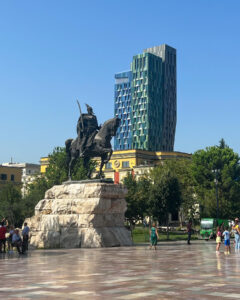
In my original itinerary, I planned for 3 weeks in the southern Balkans (before my “failure to launch,” as my dad calls my failed attempt at my initial flight). When I reconfigured the whole first part of the trip, I still had to get to Turkey by the first of September, so that meant cutting a whole week from the Balkans. Two weeks sounds like a long time, but truthfully, it’s so little time to see a region that I could have easily spent the whole 5 months in. I cut days here and there and ended up with a route that basically followed the main tourism path, which is to say, the transportation hubs where there were relatively easy bus connections to the places next in line. There were several towns I wanted to visit in Albania, but for the sake of time and ease, I settled for just one night in the capital, Tirana, on the way to Macedonia. To be honest, I didn’t have high expectations for it. I thought it would be a convenient layover and not offer us much more than a place to sleep. I hadn’t read wonderful things about the city. As it turned out, Albania is probably one of the least understood countries on my itinerary, and I did the whole country a disservice by underestimating it and only spending one night there.
We arrived in Albania after a horrifying bus journey through the mountains, and we took an equally horrifying taxi ride to our hostel. I was surprised and delighted by the hostel. Art Hostel Tirana is in a residential neighborhood right next door to local homes. It’s one of the only hostels I stayed in where I felt like, as far as location, I was immersed in what the real city felt like and not just the version of it that tourists are supposed to see. The hostel manager, Endri, was the most kind and gentle spirit, and I adored him. We walked ten minutes to one of the big city squares and ate an absolutely delicious meal for an insanely cheap price at a popular restaurant with local music. (I think this is the cheapest European capital we visited. Michael and I got 5 or 6 different dishes to share at one of the most well-known restaurants in town for dinner, and it cost about $15 total.) Kids were playing soccer in the square, and everyone was eating ice cream amongst the well-pet stray dogs. There was no performance aspect to it like I see in most cities—no one was trying to impress any tourists—they just accepted us and carried on as normal. It did not feel like a city that sees much tourism. We knew right away that we liked this place so much more than we thought we would.




We had to leave the next day, but we scheduled the latest bus we could so that we could make the most of the morning. Albania has one of the most complicated and difficult histories of any country I’ve visited yet. Though it’s a Balkan country, it’s the only one of them that was not part of former Yugoslavia. As horrible as things got during the Yugoslav wars, Albania was privately living its own more secretive nightmare. It was a communist country with a terrible dictator until the early 1990s. Under the communist leadership, it was one of the most brutal and isolated regimes in history, similar to how we might describe North Korea today. The leadership in Albania was one of excessive paranoia. They isolated the country and were able to hide most of the atrocities happening there. If anyone was suspected of anything hinting at treason, they ended up in labor camps that they’d never come out of, or they simply disappeared. They did this to their own people. Today Albania still has the most Cold War-era bunkers of any country in the world (supposedly—no one knows for sure how many there are, but there were rumored to be 750,000 at one point) because so many were built out of paranoia and fear. The bunkers are EVERYWHERE. You can see dozens of them just riding the bus through the hillsides. A couple of them have been made into museums in the center of town. Michael and I went to one that was a museum about the police force and their history. It doesn’t sound all that interesting just to read a description, but it was one of the most moving museums I’ve ever visited. It was all about how the security was complicit in the atrocities of the communist regime, and it showed the timeline of the country’s recent history. This is a country that doesn’t try to hide the mistakes of its past—they want people to learn from their mistakes so they don’t make the same ones.



I have a small list of places I’d like to visit one day when I go back to Albania. And if you plan such a trip yourself, I hope you won’t make the mistake of skipping them like I did the first time. But also, don’t let the internet fool you—Tirana is more than just a transportation hub. This is a place very much worth visiting.


